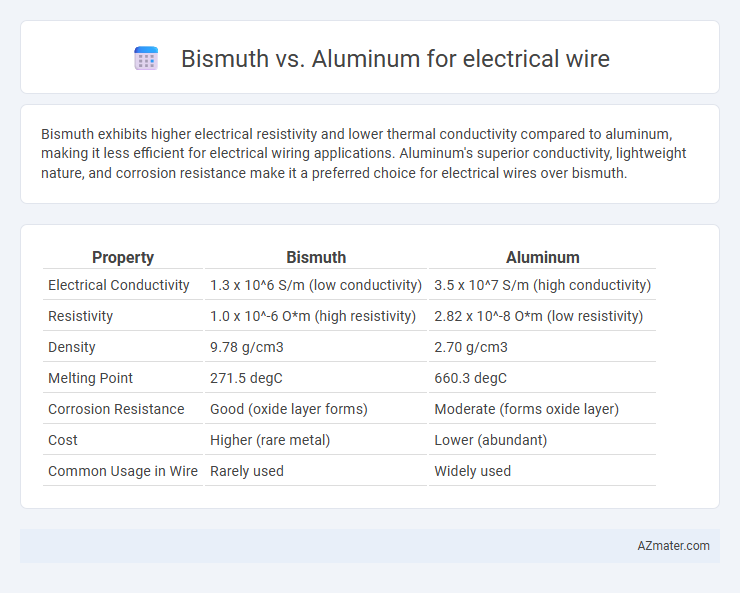Bismuth exhibits higher electrical resistivity and lower thermal conductivity compared to aluminum, making it less efficient for electrical wiring applications. Aluminum's superior conductivity, lightweight nature, and corrosion resistance make it a preferred choice for electrical wires over bismuth.
Table of Comparison
| Property | Bismuth | Aluminum |
|---|---|---|
| Electrical Conductivity | 1.3 x 10^6 S/m (low conductivity) | 3.5 x 10^7 S/m (high conductivity) |
| Resistivity | 1.0 x 10^-6 O*m (high resistivity) | 2.82 x 10^-8 O*m (low resistivity) |
| Density | 9.78 g/cm3 | 2.70 g/cm3 |
| Melting Point | 271.5 degC | 660.3 degC |
| Corrosion Resistance | Good (oxide layer forms) | Moderate (forms oxide layer) |
| Cost | Higher (rare metal) | Lower (abundant) |
| Common Usage in Wire | Rarely used | Widely used |
Introduction to Bismuth and Aluminum in Electrical Wiring
Bismuth in electrical wiring offers low thermal conductivity and high corrosion resistance, making it suitable for specialized applications requiring minimal heat transfer. Aluminum is widely used due to its lightweight nature, high conductivity-to-weight ratio, and cost-effectiveness, especially in power distribution systems. Both metals must be carefully selected based on conductivity, mechanical strength, and environmental factors in electrical wiring projects.
Material Properties: Bismuth vs Aluminum
Bismuth exhibits a higher electrical resistivity compared to aluminum, making aluminum more efficient for electrical conductivity in wiring applications. Aluminum offers superior ductility and lower density, resulting in lighter and more flexible wires suitable for long-distance power transmission. The thermal conductivity of aluminum also surpasses that of bismuth, enhancing heat dissipation and safety in electrical systems.
Electrical Conductivity Comparison
Bismuth has significantly lower electrical conductivity compared to aluminum, with bismuth exhibiting roughly 1.3% of copper's conductivity while aluminum offers about 61% of copper's conductivity. This disparity makes aluminum far more suitable for electrical wiring due to its efficient electron flow and reduced energy losses. Electrical wires predominantly use aluminum for cost-effective conductivity and better performance in power transmission applications.
Thermal Conductivity Differences
Bismuth exhibits significantly lower thermal conductivity compared to aluminum, with values around 8 W/m*K versus aluminum's approximately 237 W/m*K, making aluminum far superior for dissipating heat in electrical wiring applications. This high thermal conductivity of aluminum reduces the risk of overheating and enhances safety and efficiency in electrical circuits. Bismuth's limited heat transfer capabilities restrict its use in wires, where effective thermal management is critical for performance and longevity.
Mechanical Strength and Flexibility
Bismuth exhibits lower mechanical strength compared to aluminum, making it less suitable for applications requiring robust structural integrity in electrical wiring. Aluminum wire offers superior tensile strength and durability, which ensures better performance under mechanical stress and repeated bending. Flexibility is enhanced in aluminum, allowing easier installation and improved resistance to fatigue in electrical wiring systems.
Corrosion Resistance and Longevity
Bismuth exhibits superior corrosion resistance compared to aluminum, making it less prone to oxidation and degradation in harsh environments. While aluminum is lightweight and cost-effective, it corrodes more rapidly, especially when exposed to moisture or alkaline conditions, which reduces its longevity as an electrical wire material. Consequently, bismuth-based alloys offer enhanced durability and extended service life in electrical wiring applications where corrosion resistance is critical.
Cost and Availability of Materials
Bismuth is significantly more expensive than aluminum due to its limited production and rarity, making it a less cost-effective option for electrical wiring. Aluminum is widely available, abundant, and cheaper, which drives down the overall material cost for electrical conductors. The cost efficiency and accessibility of aluminum make it the preferred choice for large-scale electrical wiring and power transmission applications.
Safety Considerations in Electrical Applications
Bismuth offers superior non-toxicity and better thermal stability compared to aluminum, reducing risks of overheating and fire hazards in electrical wiring. Aluminum, while lightweight and cost-effective, is prone to oxidation and thermal expansion, which can cause loose connections and increase electrical resistance, presenting safety concerns. Choosing bismuth-based components enhances durability and safety by minimizing electrical faults and improving heat dissipation in critical electrical applications.
Environmental Impact: Sustainability and Recycling
Bismuth offers a more environmentally friendly alternative to aluminum for electrical wires due to its non-toxic nature and higher recyclability rate, reducing hazardous waste and promoting sustainability. Aluminum production is energy-intensive and linked to significant greenhouse gas emissions, whereas bismuth's extraction and recycling processes have a lower carbon footprint. Incorporating bismuth in electrical wiring supports circular economy principles by enabling efficient material recovery and minimizing environmental degradation.
Choosing the Right Material for Electrical Wiring
Choosing between bismuth and aluminum for electrical wiring depends on conductivity, weight, and corrosion resistance. Aluminum offers excellent conductivity and is lightweight, making it ideal for high-voltage overhead power lines, but it requires proper connectors to prevent corrosion. Bismuth, while less conductive and heavier, provides superior thermal stability and non-toxicity, which are advantageous in specialized or low-current applications.

Infographic: Bismuth vs Aluminum for Electrical wire
 azmater.com
azmater.com